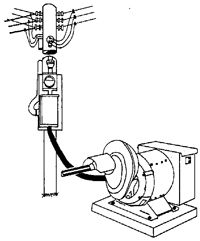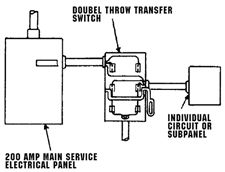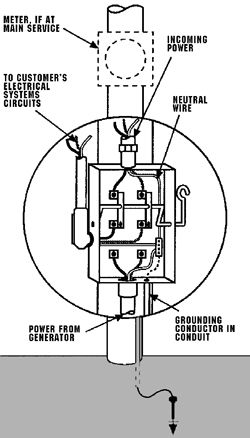Connecting Your Standby Generator Safely
Purchasing and installing a standby generator is a good way to ensure your home has a backup plan in the event of a major outage. However, proper installation, usage, maintenance, and communication are crucial to the safety of your home and our employees.
Notify us if you purchase a standby generator. This helps keep our lineworkers safe should they ever need to work on or near your home.
Call a licensed electrician for installation; do not attempt to install the generator on your own.
Once your generator has been installed, make sure a licensed professional inspects the wiring.
Always use a transfer switch to prevent dangerous backfeeding into the power grid (NEC Article 702-6).
Never run a generator indoors. Fumes can be fatal. Operate in a well-ventilated, outdoor area.
Do not shut off the generator under load.
Keep all safety shields and guards in place to protect from moving parts.
Use extreme caution in wet conditions to avoid electric shock.
Turn off and cool down the generator before refueling. Never refuel while running.
Store fuel safely in approved containers away from the generator.
For tractor-powered generators, always:
Shut off the PTO and tractor engine before servicing.
Engage the brake before starting the generator.



A transfer switch disconnects your home/farm/business from the utility grid during generator use.
Prevents backfeeding into utility lines, protecting linemen during outages.
Protects your generator from overload or damage when normal power is restored.
Double-pole, double-throw switches are required for single-phase, 120/240V systems:
Two pairs of hot wire lugs.
Neutral wire passes through (not switched).
Ground wire continues through the enclosure.
Three-phase generators require a three-pole, double-throw switch.
For CT (current transformer) metered services, a pole-top switch with a manual lever may be required.
Portable generators used for plug-in appliances (like a freezer) do not need a transfer switch.
If the generator powers circuits via home wiring, a transfer switch must be used.
Install the transfer switch between the utility meter and the building’s loads.
Keep the switch within 25 feet of the generator for safety and ease of use.
If powering multiple outbuildings, the central meter pole is often the best location for the switch and generator.
If powering a single building, install the generator and switch at the service entrance to that structure.
If only powering a few critical circuits, install a switch that connects only those circuits (see Figure 2 in the previous tab).
Match the switch rating to the size of the main service panel (commonly 100, 200, or 400 amps) if powering the whole service.
If powering a single building or select circuits, size the switch to the total amperage of connected loads.
For automatic-start generators, the transfer switch is typically built into the control system:
Must be sized to match the main conductors supplying power to the home or buildings.
Ground all standby generators using
#6 solid copper wire
An 8-foot ground rod
Approved bonding clamps to ensure good electrical contact with the system
Cover generator openings with mesh to prevent rodent entry and damage.
Keep ventilation areas clear of debris to ensure proper air flow and avoid overheating.
Regularly inspect and maintain the generator to keep it in safe working condition.
Notify us if you purchase a standby generator. This helps keep our lineworkers safe should they ever need to work on or near your home.
Call a licensed electrician for installation; do not attempt to install the generator on your own.
Once your generator has been installed, make sure a licensed professional inspects the wiring.
Always use a transfer switch to prevent dangerous backfeeding into the power grid (NEC Article 702-6).
Never run a generator indoors. Fumes can be fatal. Operate in a well-ventilated, outdoor area.
Do not shut off the generator under load.
Keep all safety shields and guards in place to protect from moving parts.
Use extreme caution in wet conditions to avoid electric shock.
Turn off and cool down the generator before refueling. Never refuel while running.
Store fuel safely in approved containers away from the generator.
For tractor-powered generators, always:
Shut off the PTO and tractor engine before servicing.
Engage the brake before starting the generator.



A transfer switch disconnects your home/farm/business from the utility grid during generator use.
Prevents backfeeding into utility lines, protecting linemen during outages.
Protects your generator from overload or damage when normal power is restored.
Double-pole, double-throw switches are required for single-phase, 120/240V systems:
Two pairs of hot wire lugs.
Neutral wire passes through (not switched).
Ground wire continues through the enclosure.
Three-phase generators require a three-pole, double-throw switch.
For CT (current transformer) metered services, a pole-top switch with a manual lever may be required.
Portable generators used for plug-in appliances (like a freezer) do not need a transfer switch.
If the generator powers circuits via home wiring, a transfer switch must be used.
Install the transfer switch between the utility meter and the building’s loads.
Keep the switch within 25 feet of the generator for safety and ease of use.
If powering multiple outbuildings, the central meter pole is often the best location for the switch and generator.
If powering a single building, install the generator and switch at the service entrance to that structure.
If only powering a few critical circuits, install a switch that connects only those circuits (see Figure 2 in the previous tab).
Match the switch rating to the size of the main service panel (commonly 100, 200, or 400 amps) if powering the whole service.
If powering a single building or select circuits, size the switch to the total amperage of connected loads.
For automatic-start generators, the transfer switch is typically built into the control system:
Must be sized to match the main conductors supplying power to the home or buildings.
Ground all standby generators using
#6 solid copper wire
An 8-foot ground rod
Approved bonding clamps to ensure good electrical contact with the system
Cover generator openings with mesh to prevent rodent entry and damage.
Keep ventilation areas clear of debris to ensure proper air flow and avoid overheating.
Regularly inspect and maintain the generator to keep it in safe working condition.
Portable Generator Safety Tips
Portable generators offer convenience but can be dangerous if used improperly. If connected directly to a home’s main electrical supply, they can back-feed electricity into utility lines and endanger repair crews. To prevent this, a licensed electrician must install a double-pole, double-throw transfer switch in compliance with local codes, using at least 10-gauge wiring. Homeowners should also calculate wattage needs carefully to avoid overloading the generator or damaging appliances.
Browse through the tabs below for more hazards and safety tips!
Never use a generator in enclosed or partially enclosed spaces. Generators can produce high levels of carbon monoxide very quickly. When you use a portable generator, remember that you cannot smell or see carbon monoxide. Even if you can’t smell exhaust fumes, you may still be exposed to it.
If you start to feel sick, dizzy, or weak while using a generator, get to fresh air right away. Do not delay. The carbon monoxide from generators can rapidly lead to full incapacitation and death.
If you experience serious symptoms, get medical attention immediately. Inform medical staff that carbon monoxide poisoning is suspected. If you experienced symptoms while indoors, have someone call the fire department to determine when it is safe to re-enter the building.
Follow the instructions that come with your generator. Locate the unit outdoors and away from doors, windows, and vents that could allow carbon monoxide to come indoors.
Install battery-operated carbon monoxide alarms or plug-in carbon monoxide alarms with battery back-up in your home, according to the manufacturer’s installation instructions. The carbon monoxide alarms should be certified to the requirements of the latest safety standards for carbon monoxide alarms (UL 2034, IAS 6-96, or CSA 6.19.01).
Test your carbon monoxide alarms frequently and replace dead batteries.
Keep the generator dry and do not use it in rainy or wet conditions. To protect from moisture, operate it on a dry surface under an open, canopy-like structure. Make sure your hands are dry before touching the generator.
Plug appliances directly into the generator. Or, use a heavy-duty, outdoor-rated extension cord that is rated (in watts or amps) at least equal to the sum of the connected appliance loads. Check that the entire cord is free of cuts or tears and that the plug has all three prongs, especially a grounding pin.
Never try to power the house wiring by plugging the generator into a wall outlet, a practice known as “backfeeding.” This is an extremely dangerous practice that presents an electrocution risk to utility workers and neighbors served by the same utility transformer. It also bypasses some of the built-in household circuit protection devices.
If you must connect the generator to the house wiring to power appliances, have a qualified electrician install the appropriate equipment in accordance with local electrical codes. Or, check with your utility company to see if it can install an appropriate power transfer switch.
For power outages, permanently installed stationary generators are better suited for providing backup power to the home. Even a properly connected portable generator can become overloaded. This may result in overheating or stressing the generator components, possibly leading to a generator failure.
Never store fuel for your generator in the home.
Gasoline, propane, kerosene, and other flammable liquids should be stored outside of living areas in properly labeled, non-glass safety containers. Do not store them near a fuel-burning appliance, such as a natural gas water heater, in your garage. If the fuel is spilled or the container is not sealed properly, invisible vapors from the fuel can travel along the ground and can be ignited by the appliance’s pilot light or by arcs from electric switches in the appliance.
Before refueling the generator, turn it off and let it cool down. Gasoline spilled on hot engine parts could ignite.
Never use a generator in enclosed or partially enclosed spaces. Generators can produce high levels of carbon monoxide very quickly. When you use a portable generator, remember that you cannot smell or see carbon monoxide. Even if you can’t smell exhaust fumes, you may still be exposed to it.
If you start to feel sick, dizzy, or weak while using a generator, get to fresh air right away. Do not delay. The carbon monoxide from generators can rapidly lead to full incapacitation and death.
If you experience serious symptoms, get medical attention immediately. Inform medical staff that carbon monoxide poisoning is suspected. If you experienced symptoms while indoors, have someone call the fire department to determine when it is safe to re-enter the building.
Follow the instructions that come with your generator. Locate the unit outdoors and away from doors, windows, and vents that could allow carbon monoxide to come indoors.
Install battery-operated carbon monoxide alarms or plug-in carbon monoxide alarms with battery back-up in your home, according to the manufacturer’s installation instructions. The carbon monoxide alarms should be certified to the requirements of the latest safety standards for carbon monoxide alarms (UL 2034, IAS 6-96, or CSA 6.19.01).
Test your carbon monoxide alarms frequently and replace dead batteries.
Keep the generator dry and do not use it in rainy or wet conditions. To protect from moisture, operate it on a dry surface under an open, canopy-like structure. Make sure your hands are dry before touching the generator.
Plug appliances directly into the generator. Or, use a heavy-duty, outdoor-rated extension cord that is rated (in watts or amps) at least equal to the sum of the connected appliance loads. Check that the entire cord is free of cuts or tears and that the plug has all three prongs, especially a grounding pin.
Never try to power the house wiring by plugging the generator into a wall outlet, a practice known as “backfeeding.” This is an extremely dangerous practice that presents an electrocution risk to utility workers and neighbors served by the same utility transformer. It also bypasses some of the built-in household circuit protection devices.
If you must connect the generator to the house wiring to power appliances, have a qualified electrician install the appropriate equipment in accordance with local electrical codes. Or, check with your utility company to see if it can install an appropriate power transfer switch.
For power outages, permanently installed stationary generators are better suited for providing backup power to the home. Even a properly connected portable generator can become overloaded. This may result in overheating or stressing the generator components, possibly leading to a generator failure.
Never store fuel for your generator in the home.
Gasoline, propane, kerosene, and other flammable liquids should be stored outside of living areas in properly labeled, non-glass safety containers. Do not store them near a fuel-burning appliance, such as a natural gas water heater, in your garage. If the fuel is spilled or the container is not sealed properly, invisible vapors from the fuel can travel along the ground and can be ignited by the appliance’s pilot light or by arcs from electric switches in the appliance.
Before refueling the generator, turn it off and let it cool down. Gasoline spilled on hot engine parts could ignite.